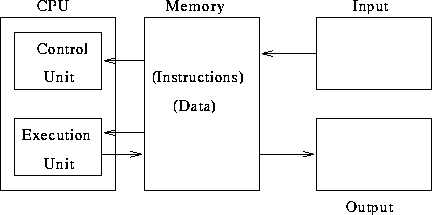
Tom Kelliher, CS 102
Sept. 5, 2001
How do I switch printers in the Lab?
How are network accounts coming along?
Read the following and be able to answer the questions.
http://www.howstuffworks.com/hard-disk.htm)
Read the entire article.
At the most basic level, where is information stored on a hard disk? What is a platter? Does a hard disk usually have more than one? What is a sector? A track?
http://www.howstuffworks.com/computer-memory.htm)
Read the first two pages.
Name two types of temporary storage. Two types of permanent storage. What is ROM? When an application is loaded or a document opened, where does it go? Why?
http://www.howstuffworks.com/question163.htm)
How does a bubble jet printer form an ink droplet? How many nozzles will it have? Can they all form droplets simultaneously?
Syllabus, survey.
Inside a computer.
A block diagram:

Consider the following simple program:
1: let sum = 0 2: print "How many numbers? " 3: read count 4: let loopCount = count 5: if loopCount equals 0 goto 11 6: print "Next number: " 7: read input 8: let sum = sum + input 9: let loopCount = loopCount - 1 10: goto 5 11: let average = sum / count 12: print "The average is:", average, "." 13: end
Conversion between binary and decimal is fairly simple, but tedious --- write/use a program.